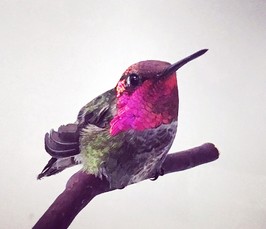Christopher Olson, Midwestern University: Vocal production by bee hummingbirds: from song centers to syrinx
Talk Christopher Olson, Seewiesen
- Datum: 12.12.2019
- Uhrzeit: 13:00 - 14:00
- Vortragende(r): Prof. Dr. Christopher Olson
- Midwestern University
- Ort: Seewiesen
- Raum: Seminar Room House 4, Tea & Coffee 12:30h
- Gastgeber: Prof. Dr. Manfred Gahr
- Kontakt: gahr@orn.mpg.de

Effective vocal communication between a sender and a recipient requires the fine tuning of a number of organ systems, including auditory organs as well as the motor circuitry that controls the vocal organs. These otherwise distinct organs are believed to occur as coevolved organ systems that must be matched between the senders and receivers to allow effective communication. Hummingbirds are highly vocal organisms that use vocal communication as major part of a larger multi-modal signaling strategy that also includes visual signals and feather-produced sounds. The bee hummingbirds are the most recent clade to have emerged in the hummingbird family, and include many of the smallest bodied hummingbirds that have radiated into north America. Bee hummingbirds are especially interesting in that vocal learning is present in some species but absent in others representing a significant loss of function of a trait that for many species is necessary for mate attraction and territory maintenance. We have been studying brain and syrinx anatomy of four bee hummingbirds that are abundant in Arizona. These include the Anna’s hummingbird which has a highly complex song, and its congener, the Costa’s hummingbird which has a less complex song. In addition, two species that are thought to have lost their song ability independently, the black-chinned hummingbird and the rufous hummingbird, are also included in our study. We use in situ hybridization for genes that are differential molecular markers of forebrain nuclei in songbird studies to understand these convergent brain circuits in hummingbirds. We note some interesting differences in vocal nuclei volume between the two singing species which may reflect the complexity of their vocal output, and the lack of a visible circuit in the non-singing hummingbirds. We also explore the use of other positive molecular markers of hummingbird neuroanatomy in an attempt to identify residual vocal forebrain structures in the non-singing species. Switching to bee hummingbird syrinx anatomy, we microCT scanned several excised vocal organs, followed by histological staining of thin tissue sections to provide a detailed look at the internal morphology of these smallest of avian sound sources. I will describe several traits that distinguish them from closely-related swifts and nightjars, and show a convergence with the syrinx of songbirds. These include an ossified and bifurcated tympanum, several accessory cartilages and multiple intrinsic muscle fascicles with different fiber orientations. Interestingly we note that singing species have larger syrinx structure with divergent morphology compared to the non-singing hummingbird species. Finally, I will discuss some future work to examine the auditory perception of hummingbird vocalizations, and finish by relating our work on the north American Bee lineage to a unique hummingbird species in se Brazil that vocalizes in a frequency range that all other avian species are believed not to hear.